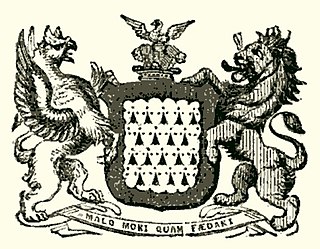Related Research Articles

Viscount Gormanston is a title in the Peerage of Ireland created in 1478 and held by the head of the Preston family, which hailed from Lancashire. It is the oldest vicomital title in the British Isles; the holder is Premier Viscount of Ireland.

Baron Trimlestown, of Trimlestown in County Meath, was a title in the Peerage of Ireland. Following the death of the 21st Baron in January 2024 with no known heir, the title is dormant, and may be extinct.

Rowland FitzEustace, 1st Baron Portlester was an Irish peer, statesman and judge. He was one of the dominant political figures in late fifteenth-century Ireland, rivalled in influence probably only by his son-in-law Garret FitzGerald, the "Great" Earl of Kildare.
Christopher Plunkett, 1st Baron of Dunsany was an Anglo-Norman peer. He was the second son of Christopher Plunkett, 1st Baron Killeen.
Sir Bartholomew Dillon was a leading Irish judge of the sixteenth century who held the offices of Chief Baron of the Irish Exchequer and Lord Justice of Ireland.
Sir William Welles was an English-born statesman and judge in fifteenth-century Ireland, who held the office of Lord Chancellor of Ireland. He was the younger brother of Lionel de Welles, 6th Baron Welles. Lionel was a prominent supporter of the House of Lancaster, who was killed at the Battle of Towton on 29 March 1461.
Sir Christopher Barnewall (1522–1575) was a leading Anglo-Irish statesman of the Pale in the 1560s and 1570s. He was the effective Leader of the Opposition in the Irish House of Commons in the Parliament of 1568–71. He is remembered for building Turvey House, where he sheltered the future Catholic martyr Edmund Campion, for his impressive tomb in Lusk Church, and for the eulogy to him in Holinshed's Chronicles, which was written by his son-in-law Richard Stanyhurst.
Nicholas St. Lawrence, 9th Baron Howth (c.1550–1607) was a leading member of the Anglo-Irish nobility in the late sixteenth and early seventeenth centuries. Despite openly professing his Roman Catholic faith, he enjoyed the trust of Elizabeth I and of successive Lord Deputies of Ireland, and was even forgiven by the English Crown for signing a petition protesting against the enforcement of the Penal Laws.
Sir Lucas Dillon, also called Luke, was a leading Irish barrister and judge of the Elizabethan era who held the offices of Attorney General for Ireland and Chief Baron of the Irish Exchequer. He supported the Lord Deputy Henry Sidney in the cess controversy and the Lord Deputy John Perrot in the Desmond Rebellions. He was held in high regard by Queen Elizabeth, but was accused by his enemies of corruption and maladministration.
Sir John Cornwalsh, or Cornwalysch was an Irish judge who held the office of Chief Baron of the Irish Exchequer. His tenure was notable for the fact that he succeeded his father as Chief Baron, and for his long struggle to retain the office in defiance of a rival claimant, Michael Gryffin. He is also remembered as the builder of Dardistown Castle in County Meath.
Christopher Bernevall, or Barnewall (1370–1446) was an Irish politician and judge of the fifteenth century, who held the offices of Vice-Treasurer of Ireland and Lord Chief Justice of Ireland. He was deeply involved in the political controversies of his time, and was a leading opponent of the powerful Anglo-Irish magnate James Butler, 4th Earl of Ormond. His elder son Nicholas also held office as Lord Chief Justice, and his younger son Robert was created the first Baron Trimleston.
Christopher St Lawrence, 2nd Baron Howth was an Anglo-Irish nobleman. He was a key figure in fifteenth-century Irish politics, and one of the strongest supporters in Ireland of the House of York, who seized the English Crown in 1461. His tomb can still be seen in the family chapel in St. Mary's Church, Howth.
Peter Rowe was an Irish judge who held the office of Lord Chief Justice of Ireland intermittently between 1388 and 1397.
Sir John Barnewall (c.1635-c.1705) was an Irish landowner, barrister and judge, who held several judicial offices, including that of Recorder of Dublin 1687-9.
Sir Thomas Fitz-Christopher Plunket (c.1407–1471) was a leading Irish lawyer and judge of the fifteenth century who held office as Lord Chief Justice of Ireland. He was an ancestor of the Duke of Wellington in the female line. His second marriage to the heiress Marian Cruise inspired the ballad The Song of Mary Cruys.
Sir Jenico d'Artois, Dartas, Dartass or Dartasso was a Gascony-born soldier and statesman, much of whose career was spent in Ireland. He enjoyed the trust and confidence of three successive English monarchs, and became a wealthy landowner in Ireland.
Baron Ratoath was a short-lived title in the Peerage of Ireland. It was created in 1468 for Sir Robert Bold, who died without male heirs in 1479.
Baron Galtrim was an Irish feudal barony: in other words, the holder of the barony, which was hereditary in the Hussey family, was entitled to style himself Lord Galtrim, but was not entitled as of right to sit in the Irish House of Lords, although at least two holders of the title did receive a summons to sit in Parliament, and a third sat in the House of Commons. The title was created in the late fourteenth century by summons to Parliament. Use of the title lapsed in the early nineteenth century: from then on the former Lord Galtrim was usually referred to simply as "Mr. Hussey of Rathkenny".
Christopher Plunkett, 6th Baron of Dunsany was an Irish nobleman.
Patrick Plunkett, 7th Baron of Dunsany was an Irish nobleman.
References
- Ball, F. Elrington The Judges in Ireland 1221-1921 London John Murray 1926
- Burke's Peerage 3rd Edition London 1846
- Lodge, Edmund British Peerage London 1838